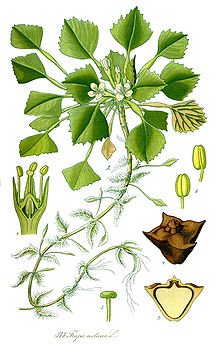Water caltrop

The water caltrop is any of three extant species of the genus Trapa: Trapa natans, Trapa bicornis and the endangered Trapa rossica. It is also known as water chestnut, buffalo nut, bat nut, devil pod, ling nut, lin kok, ling jow, ling kio nut, mustache nut or singhada.
The species are floating annual aquatic plants, growing in slow-moving water up to 5 m deep, native to warm temperate parts of Eurasia and Africa. They bear ornately shaped fruits, which in the case of T. bicornis resemble the head of a bull or the silhouette of a flying bat. Each fruit contains a single very large, starchy seed. T. natans and T. bicornis have been cultivated in China and the Indian subcontinent for the edible seeds for at least 3,000 years.
The generic name Trapa is derived from the Latin word for “thistle”, calcitrappa, as also is another common name for the water caltrop.
The Chinese name is língjiǎo (菱角), líng meaning “caltrop” and jiǎo meaning “horn”. This is often rendered as ling nut by English-speakers.
In India and Pakistan, the plant has different regional names, such as siṅghāḍā (Hindi: सिंघाडा), śṛṅgāṭaka (Sanskrit), pānī-phal (Hindi: पानीफल, Urdu: سنگھارا) śiṅgoḍā (Gujarati: શિંગોડા), heikrak (Manipuri: ꯍꯩꯀ꯭ꯔꯛ), pani singada (Odia: ପାଣିସିଙ୍ଗଡ଼ା), xiŋori (Assamese: শিঙৰি), hiṅgrai (Sylheti: ꠢꠤꠋꠞꠣꠁ). This fruit’s Bengali name is shingara/paniphol (সিঙ্গারা/পানিফল).
In Kashmiri it is called gore (گور). In Montenegro it is abundant in Lake Skadar and known as kasaronja. The plant’s name in Japanese is hishi, a word meaning “diamond- or lozenge-shaped”.
